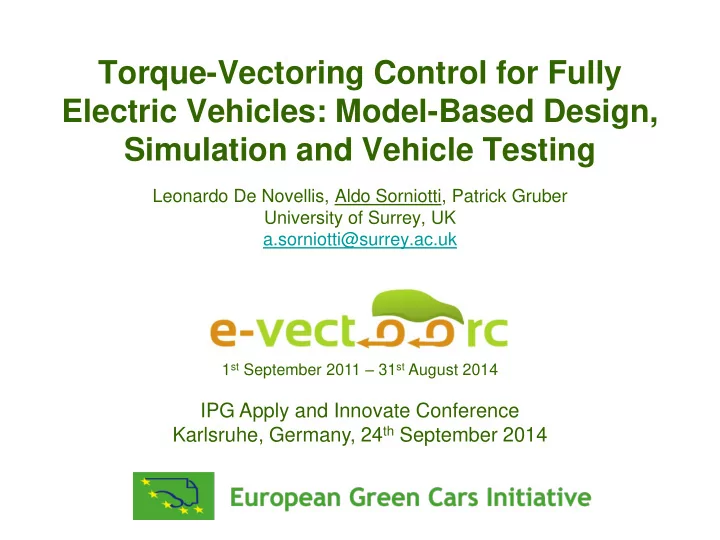

Torque-Vectoring Control for Fully Electric Vehicles: Model-Based Design, Simulation and Vehicle Testing Leonardo De Novellis, Aldo Sorniotti, Patrick Gruber University of Surrey, UK a.sorniotti@surrey.ac.uk 1 st September 2011 – 31 st August 2014 IPG Apply and Innovate Conference Karlsruhe, Germany, 24 th September 2014
Outline 1. E-VECTOORC consortium; 2. Objectives; 3. Simulation models; 4. Control structure; 5. Simulation-based testing; 6. Experimental testing; 7. Conclusions
1. E-VECTOORC Consortium 10 highly committed partners, with complementary skills and expertise: 3 large industrial companies (Jaguar Land Rover, SKODA Auto and TRW), 2 SMEs (Inverto and ViF), 3 research centres (CIDAUT, ITA and Flanders’ Drive), 2 universities (TUIL and Surrey); 6 countries involved (Austria, Belgium, Czech Republic, Germany, Spain, United Kingdom)
1. E-VECTOORC Consortium Range Rover Evoque electric vehicle demonstrator • Four on-board switched reluctance electric drivetrains; • Electro-hydraulic braking system unit with newly developed control software TRW SCB unit Inverto electric motors Drivetrain assemblies
2. Objectives Design of the reference understeer characteristic through torque-vectoring control Steering wheel angle Asymptote V=const Non-linear region Linear region Lateral acceleration 0.4-0.5 g Possible effects of torque-vectoring
2. Objectives Compensation of the variation of the understeer characteristic as a function of longitudinal acceleration and deceleration 1. Constant torque distribution 2. Torque-proportional-to-F z torque-vectoring Torque-vectoring distribution with torque-proportional-to-vertical-load (Aisin – US Patent No. 5148883, Shimada-Shibahata SAE paper 940870) Strategy 2. allows smaller range of variation of the understeer gradient but does not allow the design of the vehicle understeer characteristic
3. Simulation models Quasi-static model • Time derivatives of the state variables (e.g. yaw rate, roll angle and slip ratios) equal to zero; • Not requiring the forward integration of the equations of motion in the time domain; • Ideal for evaluating the understeer characteristic in conditions of non-zero longitudinal acceleration IPG CarMaker – Simulink model • Vehicle chassis model in CarMaker; • Drivetrain dynamics modelled in Matlab-Simulink; • Model for control system performance assessment and fine-tuning
3. Simulation models
4. Control Structure The yaw moment controller presents a hierarchical structure
4. Control Structure understeer gradient: K u = k -1 * = k dyn linear region threshold: a y * asymptotic value: a y,MAX = k dyn,0 * a k if y dyn dyn dyn * dyn dyn * * * a a k a e dyn , 0 dyn if y y , MAX dyn y , MAX dyn dyn The exponential approximation fits well with the experimental results and can be used for the analytical definition of the reference vehicle behaviour Sport mode (smaller K U , increased a y * , a y,MAX ) Normal mode ( ≈ baseline vehicle) Eco mode (same as normal mode)
4. Control Structure An optimisation procedure has been developed for achieving the target understeer characteristic through the feedforward contribution of the yaw moment Several objective functions have been implemented
4. Control Structure 1. Quasi-static model and offline optimisation procedure are employed considering an objective function (e.g., the minimisation of the overall input motor power) FF as function of , a x , V , m are implemented in the 2. The look-up tables of M z controller 3. The off-line optimisation procedure can be used for sensitivity analyses, e.g., the evaluation of the impact of the understeer gradient on power consumption The procedure works!
4. Control Structure Driving mode Understeer characteristic Control Allocation Normal Normal Squared sum of wheel torque-vertical load ratios Sport Sport Squared sum of wheel torque-vertical load ratios Eco Normal Wheel torque ratio from offline optimisation Main constraints for CA 1) Tyre friction limits 2) Motor/regeneration torque limits 3) Maximum predictive torques 4) Battery (charge/discharge) limits 5) ECE Braking regulations 6) Rate limits On-line optimisation methods have been chosen for the 3 driving modes with differences in the cost function formulation
4. Control Structure Sim. Exp. SS x x x PID + Feedforward x x Second order sub-optimal sliding mode Twisting second order sliding mode x Integral sliding mode x x H-infinity based on loop-shaping x x x Sim.: assessed through IPG CarMaker simulations Exp.: assessed through experiments SS: including sideslip control formulation
5. Simulation-based testing (V = 90 km/h; p a = 50 %) Sub-optimal SOSM PID+FF Baseline De Novellis, Sorniotti, Gruber, Pennycott, “ Comparison of Feedback Control Techniques for Torque-Vectoring Control of Fully Electric Vehicles ”, IEEE TVT (2014)
6. Experimental testing Lommel proving ground Skid pad tests (e.g., R = 30, 60 m) Step steer tests at constant torque demand (e.g., = 100 deg, V in = 90 km/h) Frequency response tests at constant torque demand ( = 20 deg, V in = 50, 90 km/h) Vehicle modes: baseline, torque-vectoring (sport mode, normal mode, VSC mode)
6. Experimental testing Torque-vectoring controller • Three driving modes (sport, normal, eco) selectable by the driver; • Vehicle response ‘designed’ through the controller Skid pad test results
6. Experimental testing Skid pad test results Step steer results • Increased yaw damping; • Reduced delay Time delay (in s) between the reference yaw rate and the actual yaw rate
7. Conclusions 1. Model-based design of the feedforward contribution of the torque- vectoring controller; 2. Control structure including feedforward and feedback contributions, designed for reduced amount of tuning time; 3. Experimental demonstration of the capability of shaping the understeer characteristic depending on the selected driving mode; 4. Experimental demonstration of the benefits (in terms of increased yaw damping) of continuous torque-vectoring control actuated through the electric motor drives with respect to the actuation of the friction brakes in emergency conditions
Happy to answer questions www.e-vectoorc.eu The research leading to these results has received funding from the European Union Seventh Framework Programme FP7/2007-2013 under grant agreement n ° 284708 For information do not hesitate to contact Aldo Sorniotti, a.sorniotti@surrey.ac.uk
Recommend
More recommend